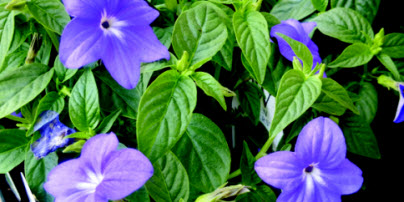Growing annuals in shade can be a tricky business. There just are not that many varieties to choose from, especially if you love flowers. Not only that, but not all shade is equal.
Shade under trees, often called dappled shade, lets in a gentle light allowing plants filtered sunlight which many annuals will tolerate. Impatiens, coleus, begonia are typical “shade” plants that require some sunlight but prefer it to be filtered.
Shade cast by buildings and fences is another matter, because the shade is very dense. Unless there is a period of day when exposed to direct sunlight for a few hours, very few plants will be able thrive or even survive.
Light is not, however, the only consideration. Shade can be dry or moist. The soil can be acidic or alkaline, depending on what causes the shade. It is often these factors that determine what can be grown and what can’t.
Dry shade is the most challenging. Very light, loamy soil can be amended with organics, such as leaf mould or compost or you can add some coir (dried coco husk) to help the soil retain water. Coir breaks down slowly and will hold three times its weight in moisture.
If the soil is really impossible, perhaps laced with tree roots that are competing for water resources, an alternative would be to sink a pot into the ground filled with your favourite moisture-loving coleus or impatiens.
Shade that is heavy and wet can impose its own limitations, but the solution is the same as for dry shade. Add organics, and if that doesn’t work, plant in containers set in the shade.
In spite of the challenges, there is one benefit to shade if you love blue, as many of the blue flowers grow in shade or part shade.
Browallia speciosa is one plant that is happy in fairly deep shade and still produces the prettiest little blue star-shaped flowers (it comes in white, too, but this colour is not so striking). Browallia is a small, 15-centimetre (six-inch), mounded plant with clear green leaves. It’s a member of the potato family (Solanaceae), with its roots in South America. It likes a rich, moist soil, so if your shade area is dry, you might want to grow it in a pot and put the pot in the shade.
Another blue annual for shade is Myosotis, the unforgettable forget-me-not, the happy little denizen of the woodland whose cheery blue flowers sparkle like tiny lights on the woodland floor. Their seeds attach to clothing or to the fur of passing animals, so they travel quickly. But a carpet of forget-me-nots in early spring is not a bad thing. This is a plant that likes a well-drained, loamy soil.
Forget-me-nots are ephemerals; that is, plants that die back after a brief, but happy life, laying down copious seed production for the following year and allowing you to plant summer blooming species in the same place.
The best flowering plant for a basket hanging in heavier shade is fuschsia, which needs less light than begonia or impatiens. Fuchsia is really a perennial in milder climates and it can handle a wide variety of conditions. While fuchsia can overwinter indoors, it’s usually infested with aphids or other crawlies, which you may prefer to avoid.
Rex begonia foliage comes in such fantastic colours and shapes that the small flowers are unnecessary. Don’t worry, though, as they probably won’t flower unless you take them inside to overwinter. They overwinter well indoors.
Annual lobelia is really a shade-loving plant that prefers cool conditions just as do pansy and viola. Lobelia also likes evenly moist conditions.
Torenia fournieri, or wishbone flower, (also known as blue wings), is another small plant, growing up to 30 centimetres (12 inches) tall, that appreciates shade. The blue, mauve or white flowers that have a spot of yellow in their throat resemble small orchids. Torenia is a member of the Scrophulariaceae family, as are snapdragons and foxglove.
Other shade-tolerant flowering annuals includes sweet alyssum (Lobularia maritima), nasturtium (Tropaeolum), Nicotiana, Dianthus and bells of Ireland (Moluccella) all handle shade to partial shade very well.
The list of non-flowering plants includes caladium, dusty miller, English ivy, grape ivy, most of the Swedish ivies (Plectranthus) and the polka dot plant (Hypoestes phyllostachya) and, of course, the shade-tolerant coleus.



